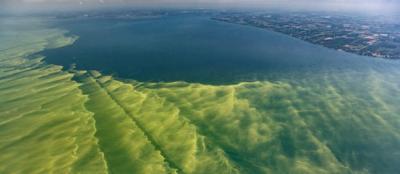Scientists at the National Oceanic and Atmospheric Administration, Ohio Sea Grant, Ohio State University’s Stone Laboratory, University of North Carolina Wilmington’s Center for Marine Science, and the Cooperative Institute for Great Lakes Research have developed an experimental forecast model for harmful algal bloom (HAB) toxins in Lake Erie.
Microcystin, the main toxin present in Lake Erie HABs, poses a threat to humans and wildlife as it is a liver toxin. NOAA does not yet have an operational HAB toxin risk forecast for Lake Erie, but NOAA Great Lakes Environmental Research Laboratory monitors HAB toxin levels in Lake Erie weekly each summer. The NOAA National Center for Coastal Ocean Science produces a daily Lake Erie HAB forecast of the algal bloom location and issues a qualitative statement on toxins based on weekly monitoring. What’s been missing is longer range forecast information about the location and timing of the toxin risk.
The new model extends NOAA’s current Lake Erie HAB forecast by incorporating weekly monitoring data into a statistical model that allows for predictions of the concentrations and locations of HABs toxins five days out. This gives water resource managers and recreational users ample time to prepare and limit exposure to microcystin.
The forecast is currently under internal review and NOAA will seek comments from the public before deploying the forecast. Once live, it will be available on NOAA’s Lake Erie HAB forecast website.
To learn more, read the full story on NOAA’s website: NOAA develops new method to forecast toxin risk from harmful algal blooms on Lake Erie


